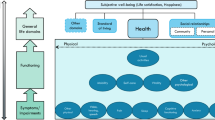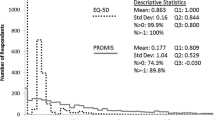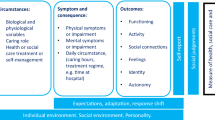Abstract
The purpose of this paper is to examine uses of quality of life (QOL) measurements at different levels of decision making within the health care system, ranging from the micro (clinical) level, through the meso (agency, institutional or regional) level to the macro and meta (governmental) levels. We use individualized, group and population-based QOL and preference assessments as illustrative examples of ways in which QOL information and decision making level interact. We conclude that the meso and macro levels pose particularly challenging problems, and suggest that, if the primary emphasis is placed on applications of QOL assessments at the micro (clinical) level of decision making, a research agenda that is much too limited may be adopted.
Similar content being viewed by others
References
Kiebert, GM, deHaes, JCJM, van deVelde, CJH. The impact of breast-conserving treatment and mastectomy on the quality of life of early-stage breast cancer patients: a review. J Clin Oncol 1991; 9: 1059–1070.
Till, JE, Sutherland, HJ, Meslin, EM. Is there a role for preference assessments in research on quality of life in oncology? Quality Life Res 1992; 1: 31–40.
Llewellyn-Thomas, HA, Thiel, EC, McGreal, MJ. Cancer patients' evaluations of their current health states: the influences of expectations, comparisons, actual health status, and mood. Med Decis Making 1992; 12: 115–122.
O'Boyle, CA, McGee, H, Hickey, A, O'Malley, K, Joyce, CRB. Individual quality of life in patients undergoing hip replacement. Lancet 1992; 339: 1088–1091.
McGee, HM, O'Boyle, CA, Hickey, A, O'Malley, K, Joyce, CRB. Assessing the quality of life of the individual: the SEIQOL with a healthy and a gastroenterology unit population. Psychol Med 1991; 21: 749–759.
Osoba, D, Aaronson, NK, Till, JE. A practical guide for selecting quality of life measures in clinical trials and practice. In: Osoba, D, ed. Effect of Cancer on Quality of Life. Boca Raton: CRC Press, 1991: 89–104.
Froberg, DG, Kane, RL. Methodology for measuring health-state preferences—II. Scaling methods. J Clin Epidemiol 1989; 42: 459–471.
Torrance, GW. Utility approach to measuring health-related quality of life. J Chronic Dis 1987; 40: 593–600.
Rosser, R. Issues of measurement in the design of health indicators: a review. In: Culyer, AJ, ed. Health Indicators. Oxford: Martin Robertson, 1983: 34–81.
Barofsky I. A conceptual model of quality of life assessment and clinical judgement. In: Zittoun R, ed. Quality of Life of Cancer Patients: A Review. Proceedings of the International Congress of Psychosocial Oncology, Beaune, France, 1992: 7–15.
Field, MJ, Lohr, KN (eds.) Guidelines for Clinical Practice: From Development to Use. Washington, DC: National Academy Press, 1992.
Knopf, KA. A Lexicon of Economics. San Diego: Academic Press, 1991.
Stanley JM (ed.) Part IV: Decisions to forgo life-sustaining treatment under conditions of scarcity. J Med Ethics 1992; 18S: 16–21.
Emanuel, EJ. The Ends of Human Life: Medical Ethics in a Liberal Polity. Cambridge, MA: Harvard University Press, 1991.
Engelhardt, HTJr. The Foundations of Bioethics. New York: Oxford University Press, 1986.
Kluge, E. Biomedical Ethics in a Canadian Context. Scarborough, ON: Prentice-Hall, 1992.
Sutherland HJ. Quality of life and decision making. Presented at the International Congress of Psychosocial Oncology, Beaune, France, October 14, 1992.
Selby, PJ, Chapman, JAW, Etezadi-Amoli, J, Dalley, D, Boyd, NF. The development of a method for assessing the quality of life of cancer patients. Br J Cancer 1984; 50: 13–22.
Sutherland, HJ, Lockwood, GA, Boyd, NF. Ratings of the importance of quality of life variables: therapeutic implications for patients with metastatic breast cancer. J Clin Epidemiol 1990; 43: 661–666.
Stevenson, W. The Study of Behaviour, Q Technique and its Methodology. Chicago: University of Chicago Press, 1953.
McNeil, BJ, Weichselbaum, R, Pauker, SG. Speech and survival: trade-offs between quality and quantity of life in laryngeal cancer. N Engl J Med 1981; 305: 982–987.
Singer, PA, Tasch, ES, Stocking, C, Rubin, S, Siegler, M, Weichselbaum, R. Sex or survival: trade-offs between quality and quantity of life. J Clin Oncol 1991; 9: 328–334.
Ebell, MH, Smith, MA, Seifert, KG, Polsinelli, K. The do-not-resuscitate order: outpatient experience and decision-making preferences. J Fam Pract 1990; 31: 630–636.
O'Connor, AM, Boyd, NF, Warde, P, Stolbach, L, Till, JE. Eliciting preferences for alternative drug therapies in oncology: influence of treatment outcome description, elicitation technique and treatment experience on preferences. J Chronic Dis 1987; 40: 811–818.
O'Connor, AM. Effects of framing and level of probability on patients' preferences for cancer chemotherapy. J Clin Epidemiol 1989; 42: 119–126.
Ware, JEJr, Sherbourne, CD. The MOS 36-item short-form health survey (SF-36). I. Conceptual framework and item selection. Med Care 1992; 30: 473–483.
Aaronson, NK, Acquadro, C, Alonso, J, et al. International quality of life assessment (IQOLA) project. Quality Life Res 1992; 1: 349–351.
Oregon Health Services Commission. Prioritization of Health Services: A Report to the Governor and Legislature. Salem, OR: Oregon Health Services Commission, 1991.
Thorne, JI. The Oregon plan approach to comprehensive and rational health care. In: Strosberg, MA, Wiener, JM, Baker, R, Fein, IA, eds. Rationing America's Medical Care: The Oregon Plan and Beyond. Washington DC: The Brookings Institute, 1992: 24–34.
Kaplan, RM. A quality-of-life approach to health resource allocation. In: Strosberg, MA, Wiener, JM, Baker, R, Fein, IA, eds. Rationing America's Medical Care: The Oregon Plan and Beyond. Washington DC: The Brookings Institute, 1992: 60–77.
Kaplan, RM, Anderson, JP. A general health policy model: update and applications. HSR: Health Services Res 1988; 23: 203–235.
Morell, V. Oregon becomes a test care for health care reform. Science 1992; 257: 1202–1203.
The Oregon Health Plan. Oregon Department of Human Resources. Office of Medical Assistance Programs. March 1993; 24.
Daniels, N. Is the Oregon rationing plan fair? JAMA 1991; 265: 2232–2235.
Veatch, RM. The Oregon experiment: needless and real worries. In: Strosberg, MA, Wiener, JM, Baker, R, Fein, IA, eds. Rationing America's Medical Care: The Oregon Plan and Beyond. Washington DC: The Brookings Institute, 1992: 78–90.
LaPuma, J. Quality-adjusted life years: ethical implications and the Oregon plan. Issues Law Med 1992; 7: 429–441.
Menzel, PT. Oregon's denial: disabilities and quality of life. Hastings Center Rep 1992; 22: 21–25.
Author information
Authors and Affiliations
Additional information
Supported by a grant from the National Cancer Institute of Canada with funds from the Canadian Cancer Society.
Rights and permissions
About this article
Cite this article
Sutherland, H.J., Till, J.E. Quality of life assessments and levels of decision making: differentiating objectives. Qual Life Res 2, 297–303 (1993). https://doi.org/10.1007/BF00434801
Received:
Accepted:
Issue Date:
DOI: https://doi.org/10.1007/BF00434801




